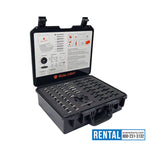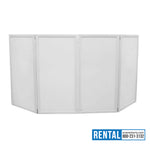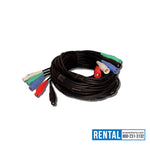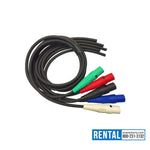You have no items in your shopping cart.
The Hidden Costs of Event Production (And How to Avoid Them)
In essence, event planning can turn into a dizzying array of choices—ranging from booking venues and engaging talent to renting equipment. Still, even meticulously crafted budgets can come undone at a moment’s notice thanks to unforeseen costs. Welcome to the often-overlooked side of event production: hidden costs.
Be it a corporate event, concert, or festival, uncovering where surprise charges originate and how to avoid them is vital. This blog uncovers the most common financial pitfalls in event production and offers smart strategies to stay on track.
1. Misjudging power and electrical requirements
Numerous first-time planners neglect that lighting, audio, and LED walls depend on substantial electrical infrastructure. More often than not, the venue’s standard outlets prove insufficient. You might be required to secure the following:
Separate power distribution panels
Especially for outdoor events, noisy generators are crucial.
Cable & cable covers
Licensed electricians
Surprise expense: If you rent additional power equipment or contract electricians last minute, you may wind up paying hundreds—or even thousands—unless you plan well in advance.
To prevent this pitfall, in the preliminary planning stage, engage your production team and request a comprehensive power assessment. Verify that the venue’s infrastructure can bear the equipment load, and, if not, book the necessary rental gear in advance.
2. Labor Costs and overtime
You may have earmarked funds for the equipment, yet what about the people responsible for putting it all in place? Labor expenses differ from location to location and may encompass:
Setup and teardown teams
Lighting and sound engineers
Truck loaders and drivers
Union labor live venues
If your event extends past schedule or the load-in process is delayed, overtime charges can skyrocket.
Methods for prevention: Construct accurate setup and strike timetables. Work with a professional event production company that clearly outlines labor needs and timelines. Be sure to set aside a 10–20% buffer for miscellaneous overtime.
3. Permits, licenses, and insurance
Organizing an outdoor concert? Permits may be required for noise, blockages of public roads, or fire safety. A number of venues insist you carry event insurance and list them as an “additional insured.” These expenses really mount — particularly when you fail to plan ahead.
Unforeseen expense: permit costs may run between $100 and upwards of several thousand dollars contingent on location, the event’s scale, and local regulations.
To sidestep it: Request a permit checklist from both the venue and the municipality as soon as possible. Enlist a production company that knows local codes and will take care of securing permits for you.
4. Venue Charges That Leave the Fine Print
You got your venue secured — did you check the fine print?
Typical venue charges you might not anticipate comprise:
Charges for earlier load-ins and delayed load-outs
Cleaning fees
Costs for securing services from outside vendors
fees for parking and providing power
How to avoid it: Go through every line of your venue contract. Be sure to inquire about what the venue covers and what it leaves out. Be sure every additional charge is itemized well ahead of time.
5. Eleventh-hour Rentals and Replacements
Did you forget to book a wireless mic for the host? Need to add additional lighting after the site visit? When you find out in the final days before the event that critical pieces are missing, panic sets in, driving panicked rentals at heightened prices.
Invisible expense: Expedited rush charges, same-day delivery, and shelling out for equipment that could have been purchased at a lower rate.
How to sidestep it: Go through your full production plan at least several weeks before the event. Work from a checklist. Encourage a team member to verify that all gear orders are correct. Engage with seasoned rental companies who will spot any shortcomings in your order.
6. Weather Contingencies
When you stage an event outdoors, nature can be your biggest budget buster. Rain, wind, or heat can generate added demands—for instance, tents or canopies, waterproof lighting and speakers, staging with drainage or non-slip surfaces, fans, or heaters.
Tents or canopies
Lighting and speakers that can tolerate weather
Equipping staging that features drainage or non-slip surfaces.
Fans—or heaters
To sidestep it: Maintain an allotted weather contingency budget. Pick equipment rated for outdoor use, and verify vendors’ policies on rescheduling or cancellations.
7. Transportation and logistics
Transporting your gear and team is not a free undertaking. Costs include:
Renting hauling vehicles or paying associated fuel surcharges
Toll and parking charges
Accommodations for crews at remote events
Loading dock delays
How to avoid it: Bundle logistics with a full-service event production company. Their connections generally yield lower rates and uniform logistics plans, thereby cutting risk and expense.
8. Wi-Fi and other Communication Infrastructure
At large venues, renting internet is frequently marked up — even more so when you’re dependent on a dedicated, high-bandwidth line for streaming or production purposes.
Hidden expense: Running temporary Wi-Fi or ethernet lines can run hundreds per day.
How to sidestep it: Firm up your technology requirements early, and insert bandwidth pricing into your venue contract. At times, it’s less expensive to supply your own mobile hotspot or bonded network service.
9. Taxes, gratuities, and service charges
A frequently neglected expense, particularly for large-scale services, is the extra 15–25 percent tacked on by service charges, taxes, and mandatory gratuities.
To avoid it: Request that each vendor provide a complete final invoice that lists every fee, not only the base price. Make sure you thoroughly review the “Terms & Conditions” document to uncover any hidden charges.
10. Post-Event Costs
After the event concludes, cleanup, damages, or missing rentals may attract additional fees. Trash disposal, stained carpets, and missing cables can cost up fast.
Prevent this occurrence: Conduct a final venue walk-through armed with a checklist. Enlist a team member to supervise the gear returns and wrap-ups with all vendors. Capture photos of the venue’s condition at the close of the event.
In closing, plan smarter and spend wiser.
The truth is this: even highly structured event budgets can still be exposed to hidden costs. But by working with an experienced event production partner, you gain foresight, structure, and savings.
Among the numerous ways they can assist, they will:
Spot and account for extra costs ahead of time.
Consolidate services to cut fees.
Manage logistics and planning for staffing.
Provide contingency plans should weather or equipment Fail
Event production is both an art and a science. Approach it right, and you’ll sidestep budget overruns—still delivering unforgettable experiences free of financial pressure.
Want assistance mastering your next event budget, from start to finish? Find out more at EventStarts.com, where expert guidance, clear pricing, and smooth planning come from seasoned event professionals.






